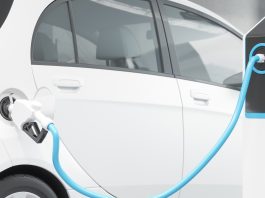Dynelectro’s Anne Lyck Smitshuysen and Søren Højgaard Jensen are making significant progress towards the company’s goal of achieving export success with its Power-to-X technology.
Founded in 2018 by Søren Højgaard Jensen, Dynelectro has developed a control unit for high-temperature electrolysis, which converts energy from solar and wind to hydrogen via the so-called Power-to-X technology. The company is now taking the next steps towards its ambition of commercial scale up.
If this goal is achieved, which the company aims to do within four to six years, Dynelectro, will have a role in producing climate-friendly fuel significantly cheaper than today – which will contribute to meeting Denmark’s overall climate goals in the long term. This venture has the potential to underpin Denmark’s role as a frontrunner in Power-to-X and will simultaneously create another green growth company with Danish roots.
From researcher to businessman
For around 20 years, Søren Højgaard Jensen has worked with electrolysis during the majority of his time as a researcher and throughout his PhD linked to the Technical University of Denmark (DTU) in Risø by Roskilde Fjord. In 2018, he took up a research position in the US, but the COVID-19 pandemic ended this prematurely. From there, work progressed quickly with the establishment of DynElectro in Syvvejen, together with Samantha Phillips, who is now the company’s Chief Commercial Officer.
The Founder’s optimism is based on a few concrete milestones. Based in a former pigsty, five engineers and the CEO are currently working with the Power-to-X technology – the core of which is the chemical process of electrolysis. The electrolysis is made in a ‘stack’, which is the basis of the electrolysis process. It consists of thin fuel cells and steel, which builds up in layers within the stack, converting electrical energy from wind and solar resources into hydrogen.
The hydrogen can be stored and converted into green fuels that can replace fossil fuels and thus reduce CO2 emissions. The conversion in the stack takes place at about 700 degrees, which makes the process very efficient because over 90% of the power turns into hydrogen.
Dynelectro has been able to improve stack performance to a degree that attracts attention around the globe. The company can make the stack up to nine times larger and thus significantly cheaper, making the production of hydrogen more competitive compared to fossil fuels.
Normally, direct current is used for electrolysis, but just by mixing direct current with a little alternating current, Dynelectro can extend the life and improve the temperature control in the stacks, so they can better withstand the current from the sun and wind being supplied.
Technological moon landing
The second milestone became known globally in December, when Physics Engineer Anne Lyck Smitshuysen succeeded in creating a fabrication process that can make electrolysis and fuel cells nine times larger than normal. This invention alone is predicted to halve the stack price and cut the total cost of producing green hydrogen by 15%. This breakthrough triggered a grant of 500,000 DKK from the Ramboll Foundation in December 2021, which referred to it as a “technological moon landing” that has the potential to accelerate the transition to green energy by several years.
Anne Lyck Smitshuysen said: “The contribution from the Ramboll Foundation of half a million kroner will enable us to take the next step, which is to get a prototype of a larger stack in place – preferably during 2022. We need extra space for this here and now.”
The next step
Søren Højgaard Jensen saw the prospects and now the patent processing is underway. There are still some steps to complete before production can begin, but Dynelectro now has the business potential to create a company with international impact.
“Once we have the prototype in place, we will build a plant in collaboration with strategic partners, where we connect the plant to wind turbines. Later, this strategic collaboration will commercialise it”, explained Søren Højgaard Jensen.
The company’s technological solutions have been noticed among other players in the field of Power-to-X.
Eva Ravn Nielsen, Chief Advisor, Power-to-X, Ramboll, said: “DynElectro has inventions and rights to several important patents that can contribute to significantly longer service life, larger cells, and more compact plants. The inventions have the potential to lead to a significant breakthrough for hydrogen technology and Power-to-X.”
PreSeed Ventures entered the ownership group in autumn, and more are expected to follow.
A growing managerial team
Dynelectro’s path from the laboratory to market also happens in the actual construction of its management. In August, the company’s researchers were joined by Karsten Klemens Hansen, who took over as CEO and who will be responsible for building and scaling the company.
“We are in the unique situation that we have some inventions that can be scaled up relatively simply and turned into a business. It is a huge market, and we are up against some big players, so we are working on entering into strategic alliances to accelerate product and technology development,” explained Karsten Klemens Hansen.
“We are still going on an escalation journey and, in this regard, we joined DI Energy at the end of 2021 to gain advice, and networking for our growth journey,” Søren Højgaard Jensen added.
Now, Dynelectro’s business plan will also be pressure- and heat-tested in the next phases of the development of the inventions that, if successful, can also contribute significantly to the green transition.
More attractive investment terms needed
Dynelectro is a good example of a green entrepreneur who, with new technology, can help us achieve our climate goals. Investing in young technology is risky, and therefore there must be good access to patient capital so that the ideas can be realised. For this reason, DI works to ensure that it is attractive for tax purposes to invest in companies, especially where the risk is high. At the same time, there is also a need to pay out the tax credits much faster than is the case today. Liquidity is crucial at a stage where a company researches and develops new products.
This story demonstrates the value of collaboration between scientists and companies. In general, we can get much better at this in Denmark. In the latest reform agreement, it was decided that the government will set up the Partnership for Knowledge and Growth, which will make suggestions on how to strengthen the framework conditions for the commercialisation of research and generally strengthen cooperation between universities, knowledge institutions, and companies. A key element is to strengthen knowledge-based entrepreneurship, for example, through spinouts from universities. We have world-class research in Denmark which must be exploited by businesses, which is why we are looking forward to the work of the partnership.
Contact info@dynelectro.dk for more information about Dynelectro’s ongoing activities.
This article has been translated, with permission, from Dansk Industri – Danish Industries.
Please note, this article will also appear in the tenth edition of our quarterly publication.









